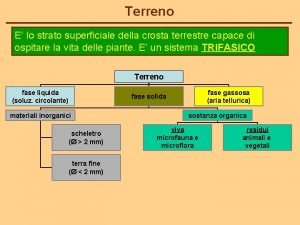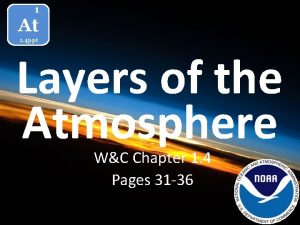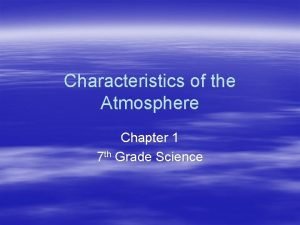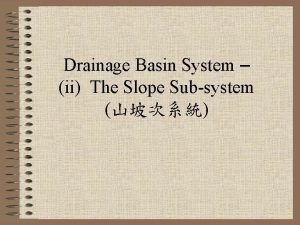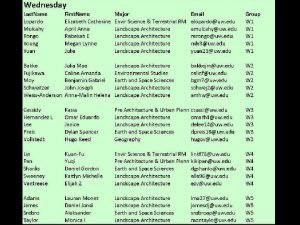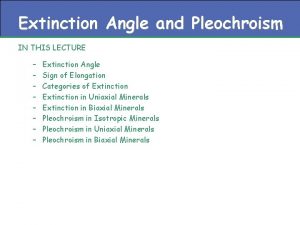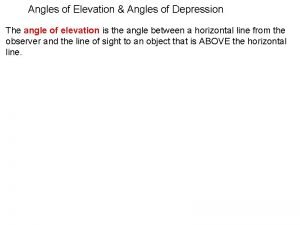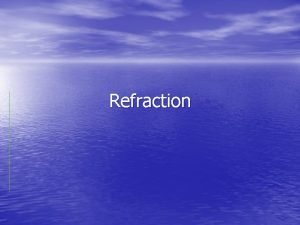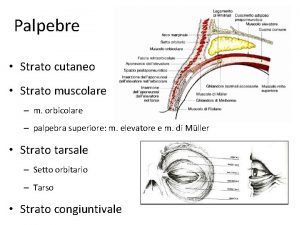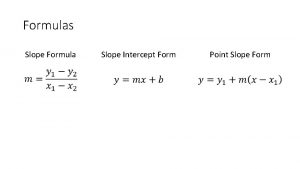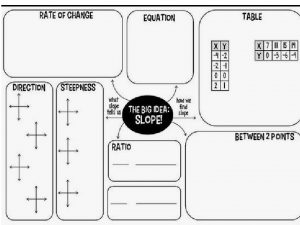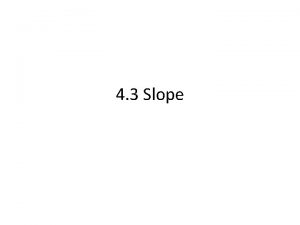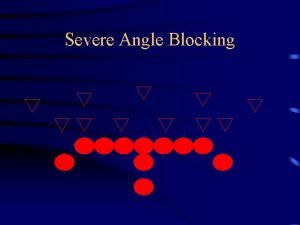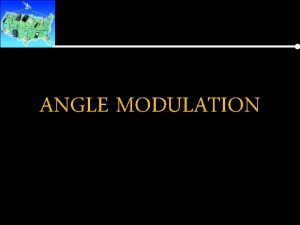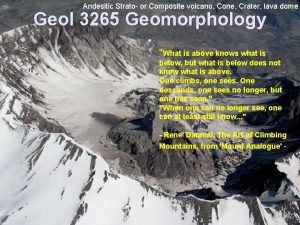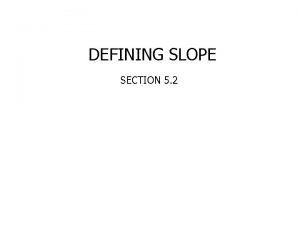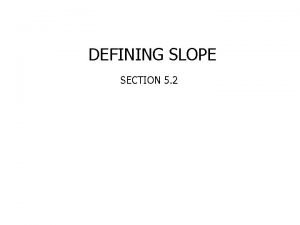The slope angle of the of strato composite


























































- Slides: 58



The slope angle of the of strato (composite) volcanoes is controlled by the angle of repose for unconsolidated pyroclasts and the viscosity properties of the silicarich andesite and dacite flows. The volcanoes shown above are part of the Aleutian Island, Alaska.

Volcanic eruptions can be classified according to the Volcanic Explosivity Index, which is based on several measurable factors that are directly related to the explosiveness of the eruption, inluding: volume of tephra ejected, cloud column height, eruption type, duration of continuous blast.

Volcanic Hazards Primary Effects -lava flows -pyroclastic eruptions -poisonous gas emissions Secondary Effects -mudflows and debris avalanches -flooding (glacial outburst floods) -tsunamis -seismicity -atmospheric effects and climate change Volcanic Hazards along the Cascadia Subduction Zone Predicting Eruptions Monitoring the Movement of Magma -seismic studies -magnetic field changes -electrical resistivity

Hawaiian Type Eruption: Basaltic composition lavas. Described as “gentle” or “effusive” eruption.

Phreatic Eruption: MSH April 4, 1980 Plinian Eruption: St. Pierre 1903

Basaltic eruptions are very fluid and will flow great distances from the vent or rift. The photo above is taken from the Kilauea rift zone on the Big Island of Hawaii.

Aa Flow, Hawaii Pahoehoe Flow, Hawaii

Few fatalities are typically associated with basaltic lava eruptions, as neighborhoods, such as the one shown here, can be evacuated. Buildings and other human-made structures are not so lucky!

Basaltic lava flow reaching a neighborhood near Kilauea, Hawaii.

Lava flow induced fire, Hawaii.

A pyroclastic flow consists of fluidized mixture of partially molten fragments and superheated expanding gases that flow down the flank of a volcanic edifide. Pyroclastic flows can exceed velocities of 100 km/hr and they are the most deadliest of volcanic hazards.

Pyroclastic eruptions and flows produce some of most devastating effects associated with volcanism. Destruction is total to any living organism or structure within the pathway of a pyroclastic flow.

Mt. St. Helens was predisposed to landsliding on the north face of the volcano because of weakened rock.

Mt. St. Helens May 18, 1980

Mount St. Helens: Pyroclastic flow May 18, 1980.

Devastation is total in the path of a pyroclastic flow. Note the twisted rebar steel in the damaged concrete support column from an Andean eruption.

Bishop ash was erupted catastrophically 760, 000 years ago in eastern California. The eruption had a VEI = 7 and ashfall accumulated as far Nebraska. The Bishop ash provides an important stratigraphic marker for middle Pleistocene-aged deposits.

Pyroclastic flows buried Pompeii, Italy under 4 m of ash in 79 AD.

Volcanic gases and particulates ejected into the atmosphere during phreatic eruptions.

Lake Nyos, Cameroon is situated within an active volcanic region of a failed rift zone. It is one of three volcanic lakes in the world that is saturated with CO 2 gas and is susceptible to catastrophic degassing when the lake water infrequently overturns.

In 1986 Lake Nyos catastrophically overturned releasing tons of dense CO 2, which killed over 1700 local inhabitants and thousands of livestock.

CO 2 gas has been emitted near the Mammoth Lakes region of California. This area is part of the Long Valley caldera, where a major VEI=7 eruption occurred 760, 000 year ago, as well as minor VEI-1 -3 eruptions forming the Inyo-Mono craters.

Seismic data tilt meters indicate that magma is upwelliing beneath the surface in the Mammoth Lakes area. This activity led USGS scientists to predict that an eruption would occur in the near future, but it will likely be small. Still waiting?

Volcanic Hazards Primary Effects -lava flows -pyroclastic eruptions -poisonous gas emissions Secondary Effects -mudflows and debris avalanches -flooding (glacial outburst floods) -tsunamis -seismicity -atmospheric effects and climate change Volcanic Hazards along the Cascadia Subduction Zone Predicting Eruptions Monitoring the Movement of Magma -seismic studies -magnetic field changes -electrical resistivity Physical Anomalies and Precursor Phenomena -ground deformation -change in heat output -change in the composition of gases -local seismic activity

Causal Factors for Lahar Flows

Lahar deposits can be recognized in the field by their poorly sorted grain-size distribution, silty matrix and composition of largely volcanic-derived sediment.

NASA 1992 Space Shuttle image of Mt. Pinatubo lahar flow deposits a year after the June 15 th, 1991 eruption.

Lahar flow from Mt. Pinotubo.

Although basaltic eruptions tend to be effusive, contact with snow and ice can create catastrophic outburst floods.

Bardarbunga caldera, Iceland produced enormous Jokulhlaups (glacial outburst floods), but did not pose a major hazard to the Icelandic people, because of its isolated location.

Effects of Volcanism on Climate Change Volcanic gases have been shown to be responsible for global cooling. The magnitude and extent of global cooling depends upon the force of the eruption, the amount of particular gases emitted and location of the eruption. When volcanic gases and fine dust reach the stratosphere, they can produce a wide spread cooling effect.

Emitted SO 2 gas combines with H 2 O to form H 2 SO 4 aerosols in the stratosphere. Aerosols, such as H 2 SO 4, reflect incoming sunlight and reduce the Earth’s surface temperature.

Volcanic eruptions that occur near the equator, such as Mt. Pinatubo, Phillippines, have a greater impact on global cooling because aerosols are erupted into the atmosphere in both hemispheres. Greatest aerosol distribution following the Mt. Pinatubo eruption of 1992 is shown in red.

Volcanism and Climate Change Mean acidity levels in the Greenland ice core strongly correlates with known volcanic eruptions. Increased volcanic activity index (based on acidity record) is inversely related to global temperature. The cooling effect tends to be 1 -3° C and last only for a 1 -2 years.

The Cascade volcanoes have variable eruption histories. Mt. St. Helens has the most frequent eruption history of the Cascade volcanoes during the Holocene.

Volcanic tephras are well-preserved in lacustrine and bog sediment throughout the Cascades. Ubiquitous organic matter provides excellent opportunities to assign radiocarbon ages to the eruptions. The Mt. Mazam O (Crater Lake) eruption occurred ~6800 years ago.

The thickness of the ash layer and grain size of ash shards provide important data regarding the volcanic source of the volcanic ash. By coring multiple lakes and/or bogs in a volcanic region the source of the eruption can be determined using the above criteria as well as the geochemistry of the tephra.

Excavating a trench behind the Hyak moraine at Snoqualmie Pass (ca. 1990).

Mt. St. Helens Wn Mt. St. Helens Yn Mazama O Three tephra layers are present in the sediment record at Snoqualmie Pass. They have been independently dated using radiocarbon dating of associated organics.

Probability hazard maps require accurate dating of preserved tephra layers.

1 A 1 B Tephra distribution of Cascade volcanoes (Mt. Mazama, Mt. St. Helens, and Glacier Peak, 1 A) compared with Longvalley (Bishop, CA) and Lava Creek (Yellowstone Park), 1 B.

Mt. Rainier’s elevation exceeded 16, 000 feet above sea level 5000 years ago. Following a large edifice collapse ~5000 years ago the mountain lost ~1500 feet of its summit.

Mt. Rainier contain 90% of the Cascade volcanoes glacial ice and permanent snow. Mt. Rainier’s glacial ice is a major potential source

A mass of sliding rocks, snow, and ice swept down the northeast side of Mount Rainier volcano about 5, 600 years ago. The large landslide transformed itself into a lahar (Osceola) and flowed down the White River into the Puget Sound.

Oceola Lahar (~5200 yr BP) near Enumclaw, WA.

Mt. Rainier volcanic hazard map (USGS).

Glacier Peak has been a very active Cascade volcano over the past 15, 000 years.

Isopachs of Glacier Peak tephra distribution (13, 100 yr BP). Eruption history and isopachs of Glacier Peak tephra distribution (13. 1 kyr BP).

Following the eruption and related lahar flow that occurred 13. 1 – 12. 5 kyr ago, drainage from Glacier Peak was diverted from the Stillaguamish River drainage to the Sauk River drainage.


Unconsolidated pyroclastic deposits on the north face of Mt. St. Helens were also a major source of lahar flows that inundated river drainages flowing from the volcano.

Reworked pyroclastics incorporated into Mt. St. Helens lahar deposits.

Primary Effects -lava flows -pyroclastic eruptions -poisonous gas emissions Secondary Effects -mudflows and debris avalanches -flooding (glacial outburst floods) -tsunamis -seismicity -atmospheric effects and climate change Volcanic Hazards along the Cascadia Subduction Zone Predicting Eruptions Monitoring the Movement of Magma -seismic studies -magnetic field changes -electrical resistivity Physical Anomalies and Precursor Phenomena -ground deformation -change in heat output -change in the composition of gases

Can we predict volcanic eruptions? Yes, but with caveats!!! 1. Requires a thorough understanding of the volcano’s eruptive history. 2. Requires appropriate instrumentation on the volcano well in advance of the eruption. 3. Requires constant monitoring of instrumentation so that incoming data can be properly interpreted. The science behind predicting volcanoes has improved substantially over the past decades, but volcanologists can only provide probabilities regarding the timing of a given eruption. It is not possible to determine the exact severity of an eruption or whether the magma will even reach the surface.

How do volcanoloists predict volcanic eruptions? 1. Monitor seismic data related to movement of magma. 2. Monitor ground deformation and dome expansion. 1. Monitor volcanic gases emitted as magma rises and expanding gases are released.

Successful Volcanic Predictions: Volcanologists predicted the eminence 1980 Mt. St. Helens eruption. Their warnings of an impending blow prompted the U. S. Forest Service to evacuate people from dangerous areas near the volcano. Although 57 people died in the eruption, it is estimated that as many as 20, 000 lives were saved. In the spring of 1991, a USGS “SWAT team” was rushed to the Philippines' Mt. Pinatubo and successfully predicted the June eruption, leading to evacuations that saved thousands if not tens of thousands of lives and millions of dollars worth of military equipment at the nearby Clark Air Force Base.
 Federica legger
Federica legger Membrana celulara
Membrana celulara Pericondrio e periostio
Pericondrio e periostio Terzo strato cubo di rubik
Terzo strato cubo di rubik Dns namensauflösung ablauf
Dns namensauflösung ablauf Triangolo granulometrico
Triangolo granulometrico Tropo strato meso thermo exo
Tropo strato meso thermo exo Tropo strato meso thermo exo
Tropo strato meso thermo exo Come risolvere il cubo di rubik facilmente
Come risolvere il cubo di rubik facilmente Strato di valenza
Strato di valenza Point-slope form definition geometry
Point-slope form definition geometry Slope review classifying slope
Slope review classifying slope Slope review classifying slope
Slope review classifying slope The difference between slope decline and slope retreat
The difference between slope decline and slope retreat Douglas fir modulus of elasticity
Douglas fir modulus of elasticity Slope angle of mt st helens
Slope angle of mt st helens The angle addition postulate answer key
The angle addition postulate answer key A central angle is an angle whose vertex is at the
A central angle is an angle whose vertex is at the Lesson 4 measuring angles
Lesson 4 measuring angles If gh is the angle bisector of fgi
If gh is the angle bisector of fgi Side side side similarity postulate
Side side side similarity postulate Inclined extinction minerals
Inclined extinction minerals A bird sits on top of a lamppost. the angle of depression
A bird sits on top of a lamppost. the angle of depression Rotary instrument in dentistry
Rotary instrument in dentistry First orthographic projection
First orthographic projection Angle klm and angle mln are complementary
Angle klm and angle mln are complementary Critical angle formula
Critical angle formula Ways to remember complementary and supplementary angles
Ways to remember complementary and supplementary angles Vertical angles
Vertical angles Absolute angle vs relative angle
Absolute angle vs relative angle Bisectors worksheet
Bisectors worksheet First angel projection
First angel projection Cutting process definition
Cutting process definition Sss congruence postulate
Sss congruence postulate Two vertical angles
Two vertical angles Hệ hô hấp
Hệ hô hấp Các số nguyên tố
Các số nguyên tố Thế nào là hệ số cao nhất
Thế nào là hệ số cao nhất Tia chieu sa te
Tia chieu sa te Slidetodoc
Slidetodoc đặc điểm cơ thể của người tối cổ
đặc điểm cơ thể của người tối cổ Các châu lục và đại dương trên thế giới
Các châu lục và đại dương trên thế giới ưu thế lai là gì
ưu thế lai là gì Tư thế ngồi viết
Tư thế ngồi viết Thang điểm glasgow
Thang điểm glasgow Cái miệng nó xinh thế chỉ nói điều hay thôi
Cái miệng nó xinh thế chỉ nói điều hay thôi Mật thư anh em như thể tay chân
Mật thư anh em như thể tay chân Tư thế ngồi viết
Tư thế ngồi viết Các châu lục và đại dương trên thế giới
Các châu lục và đại dương trên thế giới Thứ tự các dấu thăng giáng ở hóa biểu
Thứ tự các dấu thăng giáng ở hóa biểu Thẻ vin
Thẻ vin Bổ thể
Bổ thể Thơ thất ngôn tứ tuyệt đường luật
Thơ thất ngôn tứ tuyệt đường luật Hươu thường đẻ mỗi lứa mấy con
Hươu thường đẻ mỗi lứa mấy con Từ ngữ thể hiện lòng nhân hậu
Từ ngữ thể hiện lòng nhân hậu Diễn thế sinh thái là
Diễn thế sinh thái là Hát lên người ơi alleluia
Hát lên người ơi alleluia Vẽ hình chiếu vuông góc của vật thể sau
Vẽ hình chiếu vuông góc của vật thể sau Phép trừ bù
Phép trừ bù





